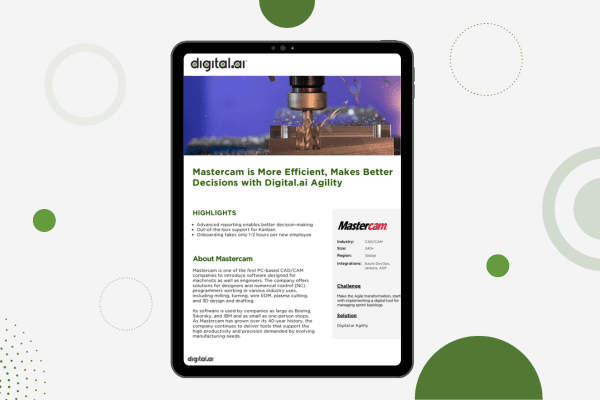What’s an Agile Workflow: Benefits and Implementation
Boost productivity & deliver value faster. Learn the principles, components, & how to implement an Agile workflow for successful product development.
Introduction to Agile Workflow
Moving quickly and efficiently while maintaining quality is crucial for success in the rapidly evolving product development landscape. Agile workflow has emerged as a highly effective methodology for improving productivity, delivering value faster, and quickly adapting to changes in requirements. Familiarizing oneself with its principles, components, and implementation strategies can lead to better project outcomes.
Understanding the Basics
Agile is rooted in flexibility, collaboration, and iterative development. It emphasizes incremental progress, customer feedback, and continuous improvement. At its core, Agile aims to break down complex projects into manageable tasks, allowing teams to respond quickly to changes and consistently deliver valuable outcomes.
The Principles of Agile Workflow
Agile is guided by 12 foundational principles, including customer satisfaction through early and continuous delivery, embracing change, delivering working software frequently, and fostering a collaborative environment between developers and business stakeholders. These principles serve as the philosophical backbone of Agile, shaping its practices and processes.
12 principles of Agile
The 12 principles of Agile are a set of guiding values and beliefs that underpin Agile methodologies. These principles, outlined in the Agile Manifesto, serve as a foundation for Agile development practices and emphasize flexibility, collaboration, and customer-centricity. Here are the 12 principles of Agile:
- Customer Satisfaction through Early and Continuous Delivery: Agile prioritizes delivering valuable software to customers early and frequently, enabling rapid feedback and adaptation to changing requirements.
- Welcome Changing Requirements, Even Late in Development: Agile embraces change as a natural and necessary part of the development process, responding to evolving customer needs and market dynamics.
- Deliver Working Software Frequently: Agile teams focus on delivering functional software increments at regular intervals, providing tangible value to stakeholders and mitigating risks associated with lengthy development cycles.
- Collaboration between Business Stakeholders and Developers: Agile fosters close collaboration and communication between business stakeholders (e.g., customers, product owners) and development teams, ensuring alignment of goals and priorities.
- Supportive, Motivated Individuals and Trusting Environment: Agile values motivated individuals empowered to make decisions and take ownership of their work. It emphasizes creating a supportive, trusting environment where teams can thrive and innovate.
- Face-to-Face Communication is Most Effective: While recognizing the importance of tools and documentation, Agile prioritizes face-to-face communication as the most effective means of conveying information, building trust, and resolving issues promptly.
- Working Software is the Primary Measure of Progress: Agile emphasizes delivering working software as the primary measure of project progress and success, focusing on tangible outcomes over documentation or process adherence.
- Sustainable Development, Maintaining a Consistent Pace: Agile promotes sustainable development by balancing the pace of work with the team’s capacity and avoiding burnout. It values maintaining a consistent pace of delivery over unsustainable bursts of activity.
- Continuous Attention to Technical Excellence and Good Design: Agile encourages a relentless focus on technical excellence and constant improvement in software development practices. It emphasizes the importance of good design, clean code, and technical debt management to ensure the product’s long-term viability.
- Simplicity – Maximizing the Amount of Work Not Done: Agile advocates for simplicity in both product design and development processes, seeking to maximize the value delivered by minimizing unnecessary work, complexity, and overhead.
- Self-Organizing Teams and Regular Reflection on How to Become More Effective: Agile empowers self-organizing teams to make decisions, solve problems, and continuously improve their processes. It encourages regular reflection and adaptation to enhance team effectiveness and performance.
- Regularly Reflect on Team Effectiveness and Adjust Accordingly: Agile teams periodically reflect on their processes, interactions, and outcomes to identify areas for improvement and adapt their approach accordingly. This principle emphasizes the importance of continuous learning and adaptation in Agile development.
These principles provide a philosophical framework for Agile methodologies, guiding teams and organizations to deliver valuable software efficiently, adapt to change, and maximize customer satisfaction.
Key Components of an Agile Workflow
Agile workflow comprises several key components, including team roles, responsibilities, artifacts, and ceremonies.
Team Roles and Responsibilities
In Agile, team members take on specific roles to ensure effective collaboration and accountability. These roles include the Product Owner, Scrum Master (in Scrum methodology), and development team members. The product owner represents the customer’s interests, prioritizes requirements, and ensures the product backlog reflects the most valuable features. Scrum masters facilitate the Agile process, remove impediments, and promote self-organization within the team. Development team members are responsible for delivering high-quality work within each iteration.
Agile Artifacts
Agile artifacts are tangible items that facilitate communication, transparency, and decision-making within the team. Common artifacts include product backlogs, sprint backlogs, user stories, and burndown charts. These artifacts provide visibility into project progress, priorities, and potential obstacles, enabling teams to make informed decisions and adapt their approach accordingly.
Agile Ceremonies
Agile ceremonies are recurring events that structure team collaboration and progress tracking. These ceremonies include sprint planning, daily stand-ups, sprint reviews, and retrospectives. Sprint planning sets the stage for upcoming work by defining sprint goals and selecting user stories for implementation. Daily stand-ups promote communication and alignment by allowing team members to share progress, discuss impediments, and plan their day. Sprint reviews showcase completed work to stakeholders, gather feedback, and validate assumptions. Retrospectives need to occur so teams can reflect on their process, identify areas for improvement, and implement actionable changes.
Implementing An Agile Workflow
Implementing Agile workflow requires careful planning, commitment, and adaptability. A step-by-step guide can streamline the transition and maximize success.
Step by Step Guide to Implementation
Assess Current Processes: Evaluate existing workflows, identify pain points, and determine readiness for Agile adoption.
- Educate Team Members: Provide training and resources to familiarize the team with Agile principles, practices, and tools.
- Define Roles and Responsibilities: Clarify team roles, establish expectations, and empower individuals to fulfill their responsibilities effectively.
- Select Agile Methodology: Choose the most suitable Agile methodology based on project requirements, team dynamics, and organizational culture (e.g., Scrum, Kanban, Lean).
- Set Up Agile Tools: Implement digital tools and platforms to support Agile practices, such as project management software, collaboration platforms, and version control systems.
- Start Small and Iterate: Begin with pilot projects or teams to test Agile practices, gather feedback, and refine processes before scaling across the organization.
- Continuously Improve: Foster a culture of continuous improvement by soliciting feedback, adapting processes, and embracing experimentation.
Choosing the Right Agile Methodology: Scrum, Kanban, and Others
Agile methodologies vary in approach, practices, and suitability for different contexts. Scrum is a popular framework characterized by fixed-length iterations (sprints), defined roles, and ceremonies. On the other hand, Kanban emphasizes visualizing workflow, limiting work in progress, and optimizing flow. Other Agile methodologies, such as Lean and Extreme Programming (XP), offer alternative approaches tailored to specific needs and preferences.
Setting Up an Agile Project
Setting up an Agile program involves establishing key components, defining project goals, and creating a conducive environment for collaboration and innovation. An Agile program includes:
- Building a product backlog.
- Setting sprint cadence.
- Establishing communication channels.
- Fostering a culture of transparency and trust.
Agile Workflow in Product Development
Agile is a product management approach designed to support the iterative, collaborative, and flexible nature of product development workflows. It enables teams to break down complex projects into smaller, more manageable tasks, known as sprints, to be completed in short time frames. By doing so, teams can quickly respond to changing customer needs and market demands, delivering value incrementally and frequently.
In an Agile workflow, transparency, communication, and teamwork are essential. Team members are encouraged to collaborate closely and share progress updates regularly. This results in high collaboration and accountability so everyone stays aligned on project goals and objectives and that any issues or challenges get addressed quickly.
Agile also emphasizes continuous improvement, with teams regularly reflecting on their processes and adjusting as needed. This approach enables teams to optimize their workflows over time, resulting in faster delivery, higher quality products, and improved customer satisfaction.
Agile is well-suited for product development workflows, particularly in fast-paced and dynamic industries. By employing this approach, teams can maintain a competitive edge in the market while creating high-quality products that meet their customers’ evolving needs and expectations.
The Role of the Product Owner
In an Agile product development environment, the product owner’s role is multifaceted and involves defining a clear product vision that aligns with the organization’s objectives, including researching and understanding customer needs, market trends, and the competitive landscape to ensure the product meets the needs of targeted buyers. Once established, the product owner facilitates communication between the development team and stakeholders.
Additionally, the product owner is responsible for prioritizing features and creating a product backlog that outlines the development team’s work. They must work closely with the development team to refine requirements, ensure they are clear and concise, and provide any necessary clarification to the team.
The product owner must also work closely with stakeholders and keep them informed of the product’s progress and changes in product vision or requirements. They must ensure that the product meets the business objectives and delivers value to the organization.
The responsibilities of the product owner are vital to the product’s success and the organization as a whole.
Navigating Product Backlogs and Sprints
Product backlogs are dynamic repositories of features, enhancements, and fixes prioritized based on business value and customer feedback. Sprints are time-boxed iterations in which development work takes place to deliver potentially shippable product increments.
Continuous Improvement and Iterative Development
Agile encourages continuous improvement through iterative development cycles, feedback loops, and retrospectives. By embracing change, soliciting feedback, and prioritizing learning, teams can adapt to market dynamics, optimize product quality, and drive innovation.
Benefits of Using Agile Workflow
Agile workflow offers numerous benefits for organizations, teams, and stakeholders, including:
Increased Productivity and Quality
Agile practices promote collaboration, transparency, and focus, resulting in higher productivity and improved product quality. By breaking down work into manageable increments and prioritizing value delivery, teams can achieve better outcomes with fewer resources.
Boosted Team Morale and Collaboration
Agile fosters a culture of empowerment, ownership, and collaboration, leading to higher team morale and satisfaction. Organizations create an autonomous, supportive, and engaged workforce by involving team members in decision-making.
High Customer Satisfaction
Agile enables organizations to respond quickly to customer feedback, adapt to changing requirements, and deliver solutions that effectively meet user needs. Organizations enhance customer satisfaction and loyalty by prioritizing customer value, soliciting feedback early and often, and delivering working software incrementally.
Common Challenges and Solutions in Agile Workflow
While Agile offers numerous benefits, it also presents challenges that organizations must address to maximize success.
Issue of Scalability
Scaling Agile across large organizations or complex projects can pose significant challenges, including coordination, alignment, and cultural resistance. Organizations can address scalability issues by implementing Agile frameworks tailored to their needs (e.g., Scaled Agile Framework – SAFe®), fostering a culture of collaboration and experimentation, and investing in training and coaching for teams and leaders.
Resistance to Change
Transitioning to Agile may encounter resistance from stakeholders accustomed to traditional approaches or skeptical of Agile’s benefits. Organizations can overcome resistance to change by providing education and communication about Agile principles and practices, demonstrating tangible benefits through pilot projects, and involving stakeholders in the transition process.
Maintaining Clear Communication
Effective communication is essential for Agile teams to collaborate, align on goals, and resolve issues efficiently. Organizations can improve communication by establishing clear channels for sharing information, fostering a culture of transparency and openness, and promoting active listening and feedback within teams.
Agile workflow offers a robust framework for boosting productivity, delivering value faster, and adapting to changing market dynamics. Organizations can harness Agile’s full potential to drive innovation, enhance customer satisfaction, and achieve sustainable growth in today’s competitive landscape by understanding its principles, components, and implementation strategies.




